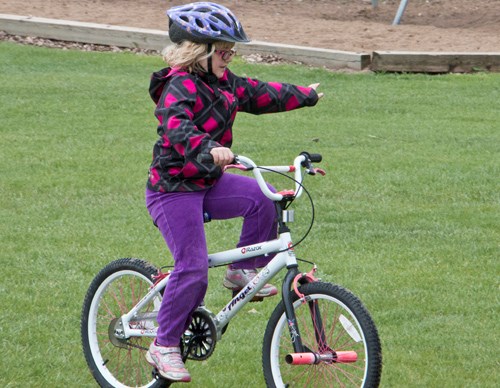With beautiful weather here and spring in full swing it’s the perfect time of year to learn about bicycle safety, which is exactly what the Carlyle Elementary School had planned on Thursday, May 28, with their annual Bicycle Rodeo.
Since a bicycle is considered a vehicle there are certain rules and safe practices which must be adhered to. CES’ Bicycle Rodeo focused on this in a fun way as students brought their bikes and helmets to school for the session.
Students in grades 1-3 were addressed at the beginning of the exercise by Cst. Beardmore who went over the different safety checks that should be done prior to riding a bike. This included a proper fitting helmet, checking the chain, brakes, handlebars, seat, pedals, reflectors and tires of the bike, as well as to be wearing shoes with laces done up and no baggy clothing.
Cst. Beardmore told the kids that clothing can get caught in the chain and that it isn’t fun to have that happen.
It’s also important to have a bicycle that fits the rider. The cyclist should be able to stand flatfooted over the bike with at least one inch of clearance from the top of the frame of the bike.
There were a total of five stations for youth to move through focused on agility, balance, safety, and the rules of the road.
Youth were taught how to ride down the right side of the street – one metre from the curb. This distance allows cyclists to be clearly visible to motorists, while able to avoid holes, debris, or other hazards in the roadway. They may move from the curb to avoid these road hazards, when turning left, or if they’re passing slower cyclists or parked cars.
When approaching parked cars they will pull out approximately one metre from them to avoid slamming into an opening door or if the vehicle suddenly pulls away from the curb. If there are a line of parked cars cyclists will stay one metre from them and will not swerve closer to the curb in between the vehicles ensuring the cyclist is visible and making predictable moves.
The students were also taught the proper hand signals for cycling to let other vehicles know whether they are turning right or left, or if they’re stopping.
Though they were taught the different hand signals, they were also made aware that a left hand turn can be dangerous as they’re approaching oncoming vehicles. For this reason the youth were taught to stop, dismount from their bike, and walk across at a crosswalk as a pedestrian.
The students also practiced agility and balance as they weaved through pylons at one station, performed a figure-eight at another station, and had to ride attempting to stay on a straight line.
For those that didn’t have bicycles the students walked or ran through the motions still learning the actions and rules of the road. If a student had a bicycle, but did not have a helmet they walked their bicycle through the various stations as per safety regulations. But for those with bicycles it was a fun way to get out and enjoy some exercise while learning the do’s and don’ts of cycling.




